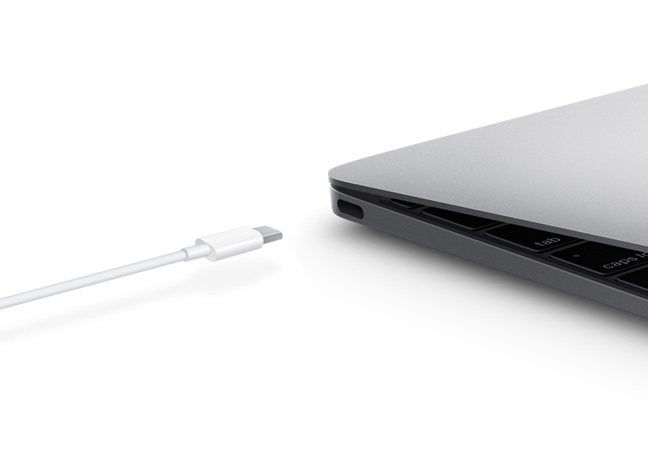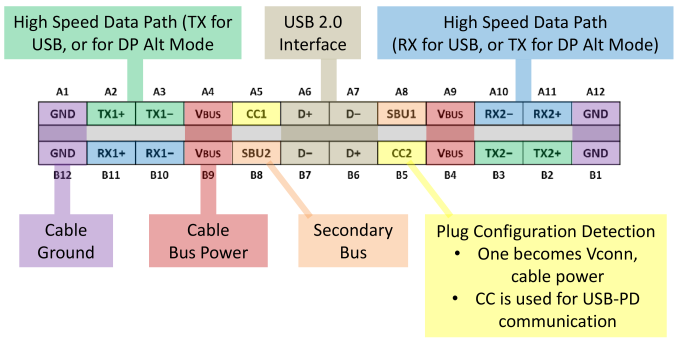USB 3.2 Update to Bring 20 Gbps Bandwidth: USB 3.1 Type-C Cables Compulsory
by Ganesh T S on July 26, 2017 7:00 PM EST
The USB 3.0 Promoters Group announced an update to the existing USB 3.1 standard in order to double the maximum possible bandwidth from 10 Gbps to 20 Gbps. This USB 3.2 specification is currently in the final draft review phase. USB 3.2 will remain backward compatible with existing USB devices.
The new specifications will retain the USB 3.1 physical layer data rates and encoding techniques. The doubling of bandwidth is achieved by going in for a two-channel operation (current USB 3.1 Gen 1/2 devices use only one 'super-speed' channel).The use of two channels is possible only if a certified USB 3.1 Type-C cable is used to connect the host and the device.
To understand this further, it is helpful to take a look at the layout of the pins in a Type-C connector.
In addition to USB transfers, the Type-C connector also supports 'alternate modes'. In these modes, the cable can carry Display Port, Thunderbolt, MHL, or HDMI signals. There are two high-speed channels in the Type-C specifications, (TX1+/TX1-, RX1+/RX1) and (TX2+/TX2-, RX2+/RX2-). USB 3.1 uses only one of these channels to achieve the required bandwidth, with the other channel (four pins) dedicated to the alternate mode signals. In some cases, if all high-speed channels are used for the alternate mode, USB transfers are restricted to using the legacy pins for USB 2.0 speeds. USB 3.2 will allow both channels (eight pins) to become available for USB transfers. Obviously, both host and client devices need to be updated to use both channels. Note that the usage of any alternate mode automatically negates the availability of the second channel between the host and the device for USB transfers.
Finally, a certified USB 3.1 Type-C cable is necessary between the USB 3.2 host and device in order to get the full performance benefits with dual lane operation. For passive cables, the USB 3.1 Gen 2 (10 Gbps) speeds are supported only if the length is 1m or shorter. The Type-C cable market is a mess, with many products in the market not carrying the proper certification, and the requisite logo (which is supposed to be in place only after the USB-IF testing process) not being prominent enough even in certified products. To make matters worse, most of the Type-C cables supplied with smartphones are limited to supporting USB 2.0 speeds only. So, consumers are advised to do proper research before purchasing Type-C cables for use with current USB 3.1 Gen 2 and future USB 3.2 systems.
The USB 3.2 update is consumer-friendly, since backwards compatibility is retained and there is no need for any new cables. Thunderbolt 3 also uses Type-C, and can go up to 40 Gbps. Its specifications are being opened up, and that makes future developments in the USB Type-C space worth keeping an eye on.











31 Comments
View All Comments
Eden-K121D - Thursday, July 27, 2017 - link
PCIe 4.0 is getting skipped to directly implement PCIe 5.0 with 32GT/s transfer speedsMajGenRelativity - Thursday, July 27, 2017 - link
True, but the DMI bus can limit it then. Depends on where the Thunderbolt port gets its PCIe lanes.repoman27 - Thursday, July 27, 2017 - link
Thunderbolt 3 has been shipping for over a year now for $8.55 (if you believe Intel's tray pricing), and contains a 4 port / 4 lane PCIe 3.0 switch and protocol converter. How are you going to connect a discrete GPU to a host PC using USB? Thunderbolt 3 is much better suited to eGPU solutions, especially now that Intel and Apple have finally given them their blessing.However, while the next PCIe revision will give Thunderbolt a bit of a bump, the link itself is still limited to 40 Gbit/s. And I'm not sure where they could even go with lane rates. The fastest transceivers in the datacenter are only pushing 28.05 Gbit/s per lane, and Thunderbolt 3 is already at 20.625 Gbit/s. Unless they add more channels, which I really don't think they will, we're probably going to be capped at 40 Gbit/s for a while.
repoman27 - Thursday, July 27, 2017 - link
Well, it looks like FPGAs can support up to 32.75 Gbit/s now, but I'm not sure how soon that type of performance will trickle down to a 2.2 W, 10.7 x 10.7 mm chip designed to provide external I/O for consumer laptops.Even a theoretical Thunderbolt 4 controller with a PCIe 4.0 x4 back end and two 30.9375 Gbit/s channels for a 60 Gbit/s link would only be equivalent to a native PCIe 3.0 x6 connection. (Ever since Thunderbolt introduced channel-bonding, there seems to be additional overhead which causes PCIe throughput to top out at 80% of what you'd normally expect.)
extide - Friday, July 28, 2017 - link
PCPer did some testing with an external GPU dock -- it actually hampers performance quite a bit -- much more so than just putting a GPU into a native PCIe 3.0 x4 slot.SharpEars - Thursday, July 27, 2017 - link
So, half as much as Thunderbolt 3. Who cares?Fergy - Thursday, July 27, 2017 - link
Exactly. Who cares about Thunderbolt when it is, at best, only 2x faster. The only thing that makes sense is to have a thunderbolt/USB 3.x usb-c port because the chance that somebody is buying a thunderbolt device is extremely low.BillBear - Friday, July 28, 2017 - link
So they've developed an alternate mode that supports another USB connection over the same cable.Morawka - Friday, July 28, 2017 - link
now it's time for Intel to actually give USB some CPU Lanes to work with. Enough with the 16 lane K series CPU's. or 4 lane i3's, we need more lanes Intel!extide - Friday, July 28, 2017 - link
Yeah having 20-24 natively off the CPU would be really nice. Hopefully pressure from AMD will finally make them do this.